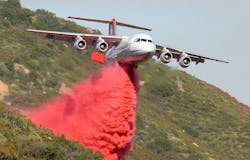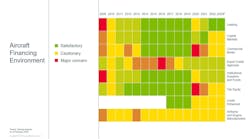In what turned out to be a very busy 2016 wildfire season in North America, the 14 in-service BAE Systems Regional Aircraft-built BAe 146-200s and Avro RJ85s of Neptune Aviation and Conair/Aero-Flite flew a combined total of well over 5,800 tanker missions, dropping in excess of 12.5 million gallons of retardant to help control some of the 67,595 recorded wildfires in the USA and well over 5,000 in Canada.
A further eight BAe 146/Avro RJs are under conversion for this demanding role, with four scheduled to enter service during 2017.
For the upcoming 2017 fire season 58% (11 out of 19) of the Large Airtankers (3,000 gallon capacity) that are contracted under United States Forest Service (USFS) Exclusive Use Contracts are BAe 146-200/Avro RJ85s, underlining the vital role now played by the aircraft.
While the 2016 fire season was not as heavy as the record-breaking 2015 season, the United States National Interagency Fire Center reported that the 67,595 wildfires burned a total of over 5.5 million acres of land. In addition, more than 5,000 wildfires had been recorded in Canada by mid-year.
The costs of wildfires are enormous. Across all agencies in the USA 2016 fire suppression costs were nearly $2 billion. Firefighting now accounts for a record 52% of the entire United States Forest Service (USFS) budget compared to just 16% in 1995.
But the biggest wildfire in North America last year was the devastating Fort McMurray fire in Alberta, Canada in the Spring where the direct and indirect costs have been pegged at nearly C$9 billion, of which the insurance cost alone is estimated at C$4 billion – the costliest ever natural disaster for Canadian insurers, according to the Insurance Bureau of Canada.
BAE Systems Regional Aircraft plays an active role in supporting both Neptune Aviation and Conair as well as Air Spray whose first BAe 146 airtanker is scheduled to fly this year. Dialogue with all three operators is on almost a weekly basis.
Support to these operators/conversions in support of their individual tanker designs include specialist engineering expertise such as aerodynamic/computational fluid dynamics analysis; dynamic loads assessment; structural analysis; as well as technical data packs; flight test planning and analysis; flight test engineers and pilots.
Airtanker operators are building their fleets by acquiring aircraft from around the globe. BAE Systems supports them additionally with the necessary technical publications and modifications (e.g. from EASA to FAA or Transport Canada Civil Aviation) during the off-season to ensure that aircraft are ready to enter service.
Once in service it is fundamental that aircraft are available and operational during the fire season (especially the Mandatory Availability Period as contracted with the USFS). BAE Systems works closely with the operators through its Repair Design Office and with comprehensive spares support to minimise downtime.
More recently BAE Systems has signed brake maintenance support contracts with both Neptune and Conair/Aeroflite, giving a competitive fixed price overhaul for aircraft brakes within a guaranteed turn-around time. Neptune has also signed up for the Tech 21 priority technical support service which nominates a dedicated engineer to ensure timely responses to technical issues.
Neptune Aviation’s fleet of seven BAe 146s flew a total of 2880 hours on airtanker operations covering almost every part of the United States plus some operations to assist in Canada. Dan Snyder, Neptune’s Chief Operating Officer explained: “We are a US national resource. Wherever the US Forest Service has the need or request we can and do get dispatched”.
He added:” the yearly utilisation average per aircraft varies greatly from year to year based on the fire season. Some years it is 200 hours per aircraft; others it can be 400 hours per aircraft. Fire operations in a day vary greatly as well. Some days there are no flights; some days only one. Sometimes it can be up to 10-15 missions a day and distance to the fire, weather and fire activity all affect this number.”
Seven of Neptune’s BAe 146s are under Exclusive Use Contracts with the USFS, along with four P2V Neptunes. An additional one BAe-146 is contracted to CalFire in California.
More recently, one of Neptune’s BAe 146s has been helping fight serious wildfires that broke out in Chile.
In addition, Neptune has acquired and is converting a further two BAe 146-200s into airtankers to be ready for this year’s fire season.
Conair of Abbotsford, Canada, and its US subsidiary Aero-Flite, has a total of seven Avro RJ85s in service as airtankers, with an eighth aircraft under conversion ready for the 2017 fire season.
Four of Conair/Aeroflite’s RJ85s are earmarked for the 2017 Exclusive Use Contracts with the USFS.
Jeff Berry, Conair’s Director of Business Development, stated that by early November the seven in-service aircraft had flown more than 430,000 km in support of wildfire operations on hundreds of operations in the lower 48th parallel and Canada during 2016. He added: “That is equivalent to a distance greater than 10 times around the world and the volume of retardant delivered to control wildfires was greater than the volume of six Olympic swimming pools.”
In addition, one of Conair’s RJ85s was recently deployed to Australia under contract to the State of Victoria to help in suppressing wildfires ‘down under’.
A further airtanker operator that has chosen the BAE Systems-built jet for its fire-fighting operations is Air Spray of Canada. It has acquired five BAe 146-200s and the first airtanker conversion is nearing completion at Air Spray USA Inc,’s engineering base at Chico, California.
Ravi Saip, Director of USA Operations, reports that the tank structure on this first aircraft is basically complete with electrical and hydraulics systems now re-instated This aircraft is scheduled to fly this Spring and to be ready for the 2017 fire season. The second aircraft is now also in work.
Wildfire statistics
* The US National Interagency Fire Center wildfire firefighting statistics and costs for 2016 (2015 for comparison) show:-
* 67,595 wildfires (68,151); 5,503,538 acres burned (10,125,149 acres)
* US Forest Service suppression costs - $1.604 billion ($1,713 billion in 2015)
* Dept Of Interior Agencies suppression costs ( includes Bureau of Indian Affairs, Bureau of Land Management, National Park Service and US Fish and Wildlife service) - $371,739,000 ($417,543,000)
* Total suppression costs $1.975 billion ($2.130 billion)
Fort McMurray, Alberta, wildfire 2016
The fire destroyed 1,800 homes + another 600 condo and apartment units and numerous other structures and forced the evacuation of more than 80,000 people. The fire began in a remote forested area south of the city on May 1 – by the early evening of May 3 the flames were inside the city and all of the city was under a mandatory evacuation order. Nobody died as a direct result of the fire. The fire was only declared under control in early July.
The direct and indirect costs of almost C$9 billion include the expense of replacing buildings and infrastructure as well as lost income, profits and royalties in the oilsands and forestry industries.
It also includes early estimates of indirect costs such as environmental damage, lost timber and physical and mental health treatment for residents and firefighters.
The study was conducted by MacEwan University economist Rafat Alam.
For more information, please contact:
David Dorman
Dorway Public relations Tel: +44 (0) 1582 488336 Mobile: +44 (0) 7831 135526 Email: [email protected]


